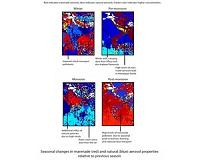 |
Paris, France (SPX) Sep 14, 2010 More wildfires have burned around the Russian capital this year than in the last decade and a half, according to sensors aboard ESA's observation satellites. The forest and peat bog fires ignited this summer amid an unprecedented heat wave of up to 40 degrees C. Working like thermometers in the sky, the Along Track Scanning Radiometer and the Advanced Along Track Scanning Radiometer on ESA's ERS-2 and Envisat satellites measure thermal-infrared radiation to take the temperature of Earth's land surface. Flames reach temperatures that are detected by these sensors and confirm the presence of fire. Data gathered from fires across Russia from July 1996 to the present were used to plot the number of fires occurring monthly. The region near Moscow showed around six times the number of fires this August compared to previous years. Data from these sensors are compiled to create ESA's ATSR World Fire Atlas which is available online to users within six hours. The atlas - the longest worldwide fire record available - also provides the time, date, longitude and latitude of the hot spots. The atlas is an important scientific resource because fires have a significant impact on global atmospheric pollution, with biomass burning contributing to the global budgets of greenhouse gases such as like carbon dioxide. The data are used for research in atmospheric chemistry, land-use change, global change ecology, meteorology and fire prevention and management.
Share This Article With Planet Earth
Related Links ESA Earthnet: ERS Earth Observation News - Suppiliers, Technology and Application
 Satellite Data Reveal Seasonal Pollution Changes Over India
Satellite Data Reveal Seasonal Pollution Changes Over IndiaChampaign IL (SPX) Sep 13, 2010 Armed with a decade's worth of satellite data, University of Illinois atmospheric scientists have documented some surprising trends in aerosol pollution concentration, distribution and composition over the Indian subcontinent. In addition to environmental impact, aerosol pollution, or tiny particles suspended in the air, can be detrimental to human health by causing a range of respiratory ... read more |
|
| The content herein, unless otherwise known to be public domain, are Copyright 1995-2010 - SpaceDaily. AFP and UPI Wire Stories are copyright Agence France-Presse and United Press International. ESA Portal Reports are copyright European Space Agency. All NASA sourced material is public domain. Additional copyrights may apply in whole or part to other bona fide parties. Advertising does not imply endorsement,agreement or approval of any opinions, statements or information provided by SpaceDaily on any Web page published or hosted by SpaceDaily. Privacy Statement |